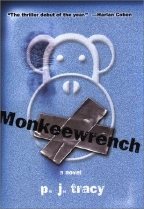Monkeewrench
P.J. Tracy
GP Putnam's Sons/Penguin-Putnam
US Hardcover First Edition
ISBN: 0-399-14978-3
Publication Date: April 14, 2003
373 Pages; $23.95
Date Reviewed: December 30, 2003
Reviewed by: Terry D'Auray © 2003

REFERENCES
COLUMNS
|
|
|
MonkeewrenchP.J. TracyGP Putnam's Sons/Penguin-PutnamUS Hardcover First EditionISBN: 0-399-14978-3Publication Date: April 14, 2003373 Pages; $23.95Date Reviewed: December 30, 2003Reviewed by: Terry D'Auray © 2003 |
|
|
REFERENCES |
COLUMNS |
With only some 200 serial killers active each year in a U.S. population of over 220 million adults, the chances of any one of us meeting up with one are, well, infinitesimally minute - squared. But readers of mystery fiction don't face such daunting odds. While none of us may ever bump into a serial killer, there's no lack of opportunity to read about one. There are probably more serial killer books out there than a person could read in a lifetime if they read absolutely nothing else. If I had a dollar for every bad serial killer book I've read, I groused, as I picked up 'Monkeewrench', the acclaimed debut novel by the mother-daughter writing team P.J. Tracy. Several hours later I can only say - keep the dollar. 'Monkeewrench' is indeed another serial killer novel, but it's a very good one, original and satisfying.
Monkeewrench is a software company that designs educational computer games for school children. Lead by the reclusive, tough-as-nails Grace Mac Bride and her four eccentric techno-geeks, Monkeewrench creates a game called SKD (serial killer detective). It's a catch-the-serial-killer game with twenty victims, each with clues, which if correctly identified, lead the game player to the next level, and the next death. Get it all right, and you'll identify the bad guy and Monkeewrench will make millions. When the Minneapolis homicide squad is called to investigate the death of an early-morning jogger, followed shortly by the discovery of the body of a young teenage runaway draped over an angel tombstone in a local cemetery, the Monkeewrench group realizes that someone is taking their game's opening line "do you want to play" for real. The Monkeewrench partners, soon suspects themselves, form an uneasy and contentious alliance with Minneapolis homicide investigators, lead by Leo Magozzi, to identify and stop the killer.
'Monkeewrench' follows the conventions of the serial killer story, with the pattern and structure we've all read many times before. Suspense is automatically conferred with "catch-before-he-kills-again" urgency. Uniquely in 'Monkeewrench', the next victim's scenario is clearly outlined beforehand by the 20-victim SKD game progression and the urgency-clock ticks rapidly with victim-a-day pacing. The cops, the software geeks, the local populace, and the reader, all know where the next violent death will occur. While the cops and geeks are trying to prevent it, the populace and the media are flocking and frothing at the ghoulish spectacle of 'round-the-clock televised violence. While the cops rely on forensics and footwork to uncover the killer, the true key to the puzzle is -- all together now -- getting inside the twisted mind of the killer and deciphering his psychic motivation. Very good, Clarice. Here Tracy (or, the Tracys) plays fair, providing enough clues for the dedicated puzzle solver to figure out the killer's identity without diminishing the surprise for the rest of us who aren't inclined to work it out on our own. The denouement is tense, violent and appropriately scary - a warehouse-cum-office with a steel door keeping the cops outside; a forced power outage providing inky darkness; the killer, as yet unidentified, inside, moving inexorably toward the true, and unforetold, target. All pretty typical SK stuff, well done but not highly original.
'Monkeewrench' moves ahead of the standard SK pack with Tracy's exceptional characterizations and superb prose. Grace MacBride is a uniquely drawn and completely riveting female character. When she's on-screen, all eyes are focused solely on her. A mix of opposites -a tough loner who's never without a gun (she even carries one in her bathrobe pocket), she's also a compassionate and loyal friend, who's scarred with a traumatic past. The other Monkeewrench partners are equally well developed, each distinct, colorful and original. So, too, are the cops. Leo Magozzi and his partner, Gino, are decent, dedicated pros with solid Midwestern values, realistic sensibilities and an easy camaraderie; the cops from Wisconsin, who weave throughout a parallel story, are small town but not small-minded, too savvy to ever be labeled hicks. There are a lot of characters in this novel and none is shortchanged. Nor is the reader.
All these characters, and significant pieces of the narrative, are set forth in Tracy's lively dialogue, a dialogue that is clever, witty and funny but never treads into forced sit-com cuteness. Whole chapters, albeit short ones, are written entirely in dialogue that is of Robert Parker or Elmore Leonard caliber. With wonderful interactions between characters - cops with cops, geeks with geeks, cops with geeks, and especially men with women - the story zips along crisply and the reader has but to keep smiling, and turning the pages.
Knowing that a mother-daughter team wrote 'Monkeewrench', I kept looking for the seams, the transitions from one writer to the other. Did one write the women, the other the men; one Minneapolis, the other Wisconsin; one the geeks, the other the cops? There are no visible seams, just a mind-melded narrative that hums along with energy and purpose. How did they do that? Just when I thought it was safe to give the whole serial killer sub-genre a rest, along come the Tracys and throw a monkey wrench into my plan.